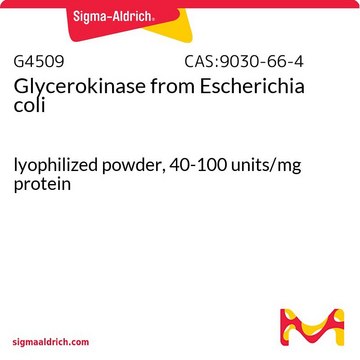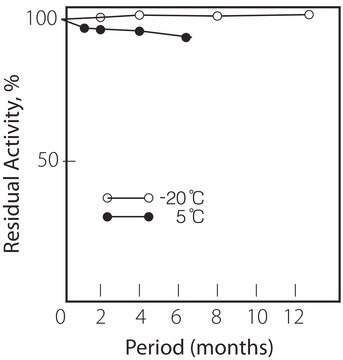G0774
Glycerokinase from Bacillus stearothermophilus
buffered aqueous solution, ≥75 units/mg protein (biuret)
Sinonimo/i:
ATP:glycerol 3-phosphotransferase, Glycerol Kinase
About This Item
Prodotti consigliati
Origine biologica
Bacillus sp. (Bacillus steaarothermophilus)
Saggio
≥5.0 mg protein/mL (biuret)
Forma fisica
buffered aqueous solution
Attività specifica
≥75 units/mg protein (biuret)
Condizioni di stoccaggio
dry at room temperature
Colore
beige
applicazioni
life science and biopharma
Temperatura di conservazione
2-8°C
Informazioni sul gene
Bacillus sp. ... glpK(89613566)
Cerchi prodotti simili? Visita Guida al confronto tra prodotti
Descrizione generale
Glycerol kinase is encoded by the GK gene on chromosome Xp21.2. Glycerol kinase is predominantly active in the liver.
Applicazioni
Azioni biochim/fisiol
Definizione di unità
Stato fisico
Avvertenze
Danger
Indicazioni di pericolo
Consigli di prudenza
Classi di pericolo
Resp. Sens. 1
Codice della classe di stoccaggio
11 - Combustible Solids
Classe di pericolosità dell'acqua (WGK)
WGK 3
Punto d’infiammabilità (°F)
Not applicable
Punto d’infiammabilità (°C)
Not applicable
Dispositivi di protezione individuale
Eyeshields, Gloves, type N95 (US)
Certificati d'analisi (COA)
Cerca il Certificati d'analisi (COA) digitando il numero di lotto/batch corrispondente. I numeri di lotto o di batch sono stampati sull'etichetta dei prodotti dopo la parola ‘Lotto’ o ‘Batch’.
Possiedi già questo prodotto?
I documenti relativi ai prodotti acquistati recentemente sono disponibili nell’Archivio dei documenti.
I clienti hanno visto anche
Il team dei nostri ricercatori vanta grande esperienza in tutte le aree della ricerca quali Life Science, scienza dei materiali, sintesi chimica, cromatografia, discipline analitiche, ecc..
Contatta l'Assistenza Tecnica.








